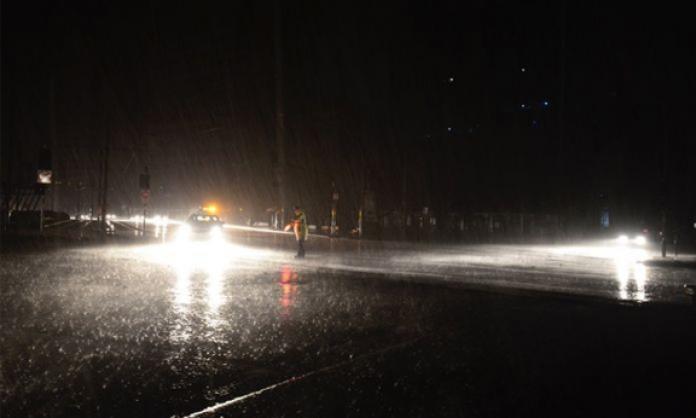South Australia was enveloped by darkness last September when a major storm caused a state-wide power outage. Little did we know, as we waited in candlelit confusion, that a much more sinister form of darkness was about to rear its head: the Liberals’ Jurassic hatred of renewable energy.
Malcolm Turnbull attacked South Australia’s alleged over-reliance on wind and solar power, which he said created strains on the electricity grid and caused the blackouts. Others also jumped at the chance to construct a renewable bogeyman. Nick Xenophon, the world’s most boring populist, claimed to support renewables while at the same time saying that South Australia used too much wind energy and calling for an inquiry into the state’s power supply.
One Nation nutcase Malcolm Roberts called for federal and state governments to “exit all climate change policies”. Barnaby Joyce was feeling particularly didactic: “[Wind power] wasn’t working too well last night, because they had a blackout”.
Viral images of pylons, collapsed and disfigured by the fierce storm, seemed to tell a different story. The failure was one of electricity distribution, rather than an issue with the source.
South Australia endured further widespread blackouts after storms in December. In February, power was deliberately cut from more than 40,000 Adelaide households in the middle of a major heat wave. During the same heat wave, Sydney residents were told to stop using energy to avoid blackouts.
Who should we blame for these failures?
The supply breakdowns have a clear basis in neoliberal policy. For decades both Liberal and Labor have followed a simple rule: privatise everything that moves. Today, even the most essential parts of modern life, such as energy, operate according to the anarchic impulses of the capitalist market.
It is a testament to the irrationality of the profit system that the Australian Energy Market Operator can order a blackout for tens of thousands in sweltering heat, and cite generation costs as a legitimate excuse. There was no shortage of supply in the state; generators were simply not turned on in preparation for the heat wave.
This is not new. Private energy companies are not primarily interested in energy consumption, but in getting a large return on their investment. High electricity prices last year, for which renewables were also scapegoated, were actually the result of market manipulation.
South Australian generators, despite a capacity far above demand, withheld supply in order to push up prices and boost profitability. And there sure are profits to be made! In 2014, distributor SA Power Networks (majority owned by billionaire Li Ka-Shing) made a whopping after-tax profit of $420 per customer, more than four times that of its UK counterpart.
The same problems underpin the failures of our shoddy infrastructure, which is recklessly maintained (or not maintained) by cost-anxious companies. Take, for example, South Australia’s crippled pylons. These towers are operated by the transmission company ElectraNet. ElectraNet had been warned by regulators as early as 2005 that 43 high-voltage transmission towers could collapse in windy conditions, given weak foundations, corrosion and degradation. The company did nothing.
That neoliberal energy chaos is blamed on renewables is bitterly ironic. The chaos, outages and high prices have been accompanied by record-breaking heat waves, linked to global warming. The longer Australia’s rulers maintain their fossil fuel fetish and climate vandalism, the crueller the weather events will become.
The heart of Australian capitalism is a lump of coal. While parts of Australia reached temperatures in the mid to high 40s during the most recent heat wave, Scott Morrison stood in parliament holding a brick of coal and denouncing “coalaphobia” as a scourge on the country. He stands in a long tradition of Australian politicians bowing to big business; each year tens of billions are raked from coal, and oil and gas extraction.
While mining and fossil fuel companies get rich off trashing our world, it is workers and the poor who are hurt the most by weather disasters. Heat waves, and accompanying bushfires, remain Australia’s deadliest weather events, and are projected to take more lives with each passing year. No-one should have to dread the electricity bill when figuring whether or not to use an airconditioner. No-one should be thrown into powerless hours, in which food is lost to the heat.
We live in a world where energy could be supplied to all and from renewable resources. If there were the political will, the trillions of dollars lost globally to militarism and tax evasion could be spent on rapidly transferring the world to 100 percent renewables. But there is no political will, even when it comes to the most basic measures.
This is evident in the case of South Australia, where, despite relatively higher renewable usage, energy distribution is unfair and ineffective. The situation could immediately be changed if energy were nationalised and desperately needed infrastructure upgrades were planned.
But even to do this would fly in the face of the dominant neoliberal doctrine. Instead, the energy system remains privatised, and the Labor government’s only solution to unemployment is to push for fracking and nuclear waste dumps. Up next: the Death Star!
Ultimately we need a society where the right of corporate profiteers to exploit the planet is suppressed, in favour of the long term needs of the majority.








